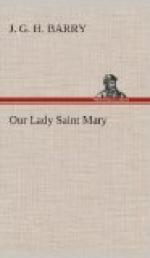And the upshot of the whole matter is that in none of these documents have I found any expressed intention to depart from the Faith of the Catholic Church of the past as that Faith had been set forth by authority. No doubt in the Homilies there are things said which cannot be reconciled with the Faith of Catholic Christendom. But the Homilies are of no binding authority, and I have included them in my investigation only because I wanted their point of view. That is harmonious with the rest of the authoritative documents—the intention is to hold the Faith: unfortunately the knowledge of some of the writers was not as pure as their intention.
The point that I am concerned with is this: there is no intention anywhere shown in the authoritative documents of the Anglican Church to effect a change in religion, or to break with the religion which had been from the beginning taught and practised in England. The Reformation did not mean the introduction of a new religion, but was simply a declaration of governmental independence. I will quote somewhat at length from the documents for the purpose of showing that there is no indication of an intention to set up a new Church.
One or two quotations from pre-reformation documents will make clear the customary phraseology in England during the Middle Ages. King John’s Ecclesiastical Charter of 1214 uses the terms “Church of England” and “English Church.” The Magna Charta of 1215 grants that the “Church of England shall be free and have her rights intact, and her liberties uninjured.” The Articuli Cleri of 1316 speak of the “English Church.” The Second Statute of Provisors of 1390 uses the title “The Holy Church of England.” “The English Church” is the form used in the Act “De Haeretico Comburendo” of 1401, as it is also in “the Remonstrance against the Legatine Powers of Cardinal Beaufort” of 1428[1].
[Footnote 1: Documents in Gee & Hardy.]
These quotations will suffice to show the customary way of speaking of the Church in England. If this customary way of speaking went on during and after the Reformation the inference is that there had no change taken place in the way of men’s thinking about the Church; that they were unconscious of having created a new or a different Church. We know that the Protestant bodies on the Continent and the later Protestant bodies in England did change their way of thinking about the Church from that of their fathers and consequently their way of speaking of it. But the formal documents of the Church of England show no change. “The Answer of the Ordinaries” of 1532 appeals as authoritative to the “determination of Scripture and Holy Church,” and to the determination of “Christ’s Catholic Church.” The “Conditional Restraint of Annates” of 1532 protests that the English “as well spiritual as temporal, be as obedient, devout, catholic, and humble children of God and Holy Church, as any people be within any realm christened.” In the




